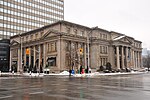University of Toronto Faculty of Music
1844 establishments in CanadaEducational institutions established in 1844Music schools in CanadaUniversity of Toronto
The Faculty of Music at the University of Toronto is one of several professional faculties at the University of Toronto. The Faculty of Music is located at the Edward Johnson Building, just south of the Royal Ontario Museum and north of Queen's Park, west of Museum Subway Station. MacMillan Theatre and Walter Hall are located in the Edward Johnson Building. The Faculty of Music South building contains rehearsal rooms and offices, and the Upper Jazz Studio performance space is located at 90 Wellesley Street West. In January 2021, the Faculty announced Dr. Ellie Hisama as the new Dean starting July 1, 2021.
Excerpt from the Wikipedia article University of Toronto Faculty of Music (License: CC BY-SA 3.0, Authors).University of Toronto Faculty of Music
Helga and Mike Schmidt Performace Terrace, Toronto
Geographical coordinates (GPS) Address Website Nearby Places Show on map
Geographical coordinates (GPS)
| Latitude | Longitude |
|---|---|
| N 43.666717 ° | E -79.394621 ° |
Address
University of Toronto (University of Toronto - St. George Campus)
Helga and Mike Schmidt Performace Terrace
M5S 2E5 Toronto
Ontario, Canada
Open on Google Maps









